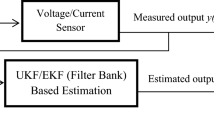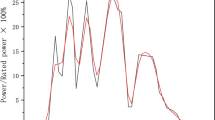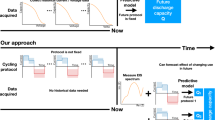Abstract
To optimize the safety of batteries, it is important to understand their behaviours when subjected to abuse conditions. Most early efforts in battery safety modelling focused on either one battery cell or a single field of interest such as mechanical or thermal failure. These efforts may not completely reflect the failure of batteries in automotive applications, where various physical processes can take place in a large number of cells simultaneously. In this Perspective, we review modelling and testing approaches for battery safety under abuse conditions. We then propose a general framework for large-scale multi-physics modelling and experimental work to address safety issues of automotive batteries in real-world applications. In particular, we consider modelling coupled mechanical, electrical, electrochemical and thermal behaviours of batteries, and explore strategies to extend simulations to the battery module and pack level. Moreover, we evaluate safety test approaches for an entire range of automotive hardware sets from cell to pack. We also discuss challenges in building this framework and directions for its future development.
This is a preview of subscription content, access via your institution
Access options
Access Nature and 54 other Nature Portfolio journals
Get Nature+, our best-value online-access subscription
$29.99 / 30 days
cancel any time
Subscribe to this journal
Receive 12 digital issues and online access to articles
$119.00 per year
only $9.92 per issue
Buy this article
- Purchase on Springer Link
- Instant access to full article PDF
Prices may be subject to local taxes which are calculated during checkout



Similar content being viewed by others
References
Fotouhi, A. et al. A review on electric vehicle battery modelling: From Lithium-ion toward Lithium-Sulphur. Renew. Sust. Energ. Rev. 56, 1008–1021 (2016).
Abada, A. et al. Safety focused modeling of lithium-ion batteries: A review. J. Power Sources 306, 178–192 (2016).
Deng, D. Li-ion batteries: basics, progress, and challenges. Energ. Sci. Eng. 3, 385–418 (2015).
Bandhauer, T., Garimella, S. & Fuller, T. A critical review of thermal issues in lithium-ion batteries. J. Electrochem. Soc. 158, R1–R25 (2011).
Wang, Q. et al. A critical review of thermal management models and solutions of lithium-ion batteries for the development of pure electric vehicles. Renew. Sust. Energ. Rev. 64, 106–128 (2016).
Xia, B. et al. Multiple cell lithium-ion battery system electric fault online diagnostics. In Transportation Electrification Conference and Expo (ITEC) 1–7 (IEEE, 2015).
Balakrishnan, P., Ramesh, R. & Kumar, T. Safety mechanisms in lithium-ion batteries. J. Power Sources 155, 401–414 (2006).
Doughty, D. & Roth, E. A general discussion of Li ion battery safety. Electrochem. Soc. Inter. 21, 37–44 (2012).
Hatchard, T. et al. Thermal model of cylindrical and prismatic lithium-ion cells. J. Electrochem. Soc. 148, A755–A761 (2001).
Roth, E. & Doughty, D. Thermal abuse performance of high-power 18650 Li-ion cells. J. Power Sources 128, 308–318 (2004).
Finegan, D. et al. In-operando high-speed tomography of lithium-ion batteries during thermal runaway. Nat. Commun. 6, 6924 (2015).
Smith, K. et al. Thermal/electrical modeling for abuse-tolerant design of lithium ion modules. Int. J. Energy Res. 34, 204–215 (2010).
Ramadass, P., Fang, W. & Zhang, Z. Study of internal short in a Li-ion cell I. Test method development using infra-red imaging technique. J. Power Sources 248, 769–776 (2014).
Orendorff, C., Roth, E. & Nagasubramanian, G. Experimental triggers for internal short circuits in lithium-ion cells. J. Power Sources 196, 6554–6558 (2011).
Cai, W. et al. Experimental simulation of internal short circuit in Li-ion and Li-ion-polymer cells. J. Power Sources 196, 7779–7783 (2011).
Yoshida, T. et al. Safety performance of large and high-power lithium-ion batteries with manganese spinel and meso carbon fiber. Electrochem. Solid State Lett. 10, A60–A64 (2007).
Zeng, Y. et al. Overcharge investigation of lithium-ion polymer batteries. J. Power Sources 160, 1302–1307 (2006).
Maleki, H. & Howard, J. Effects of overdischarge on performance and thermal stability of a Li-ion cell. J. Power Sources 160, 1395–1402 (2006).
Maleki, H. & Howard, J. Internal short circuit in Li-ion cells. J. Power Sources 191, 568–574 (2009).
Feng, X. et al. Characterization of penetration induced thermal runaway propagation process within a large format lithium ion battery module. J. Power Sources 275, 261–273 (2015).
Cai, L. & White, R. Mathematical modeling of a lithium ion battery with thermal effects in COMSOL Inc. Multiphysics (MP) software. J. Power Sources 196, 5985–5989 (2011).
Kim, G. et al. Multi-domain modeling of lithium-ion batteries encompassing multi-physics in varied length scales. J. Electrochem. Soc. 158, A955–A969 (2011).
Gerver, R. & Meyers, J. Three-dimensional modeling of electrochemical performance and heat generation of lithium-ion tabbed planar configurations. J. Electrochem. Soc. 158, A835–A843 (2011).
Guo, M. & White, R. A distributed thermal model for a Li-ion electrode plate pair. J. Power Sources 221, 334–344 (2013).
Doyle, M., Fuller, T. & Newman, J. Modeling of galvanostatic charge and discharge of the lithium/polymer/insertion cell. J. Electrochem. Soc. 140, 1526–1533 (1993).
Fuller, T., Doyle, M. & Newman, J. Simulation and optimization of the dual lithium ion insertion cell. J. Electrochem. Soc. 141, 1–10 (1994).
Fang, W., Ramadass, P. & Zhang, Z. Study of internal short in a Li-ion cell – II. Numerical investigation using a 3D electrochemical-thermal model. J. Power Sources 248, 1090–1098 (2014).
Chui, K. et al. An electrochemical modeling of lithium-ion battery nail penetration. J. Power Sources 251, 254–263 (2014).
Zhao, W., Luo, G. & Wang, C. Modeling nail penetration process in large-format Li-ion cells. J. Electrochem. Soc. 162, A207–A217 (2015).
Sahraei, E., Campbell, J. & Wierzbicki, T. Modeling and short circuit detection of 18650 Li-ion cells under mechanical abuse conditions. J. Power Sources 220, 360–372 (2012).
Greve, L. & Fehrenbach, C. Mechanical testing and macro-mechanical finite element simulation of the deformation, fracture, and short circuit initiation of cylindrical lithium ion battery cells. J. Power Sources 214, 377–385 (2012).
Avdeev, I. & Gilaki, M. Structural analysis and experimental characterization of cylindrical lithium-ion battery cells subject to lateral impact. J. Power Sources 271, 382–391 (2014).
Zhang, C. et al. Coupled mechanical-electrical-thermal modeling for short-circuit prediction in a lithium-ion cell under mechanical abuse. J. Power Sources 290, 102–113 (2015).
Zhang, C. et al. A representative-sandwich model for simultaneously coupled mechanical-electrical-thermal simulation of a lithium-ion cell under quasi-static indentation tests. J. Power Sources 298, 309–321 (2015).
Hu, X., Li, S. & Peng, H. A comparative study of equivalent circuit models for Li-ion batteries. J. Power Sources 198, 359–367 (2012).
Shabani, B. & Biju, M. Theoretical modelling methods for thermal management of batteries. Energies 8, 10153–10177 (2015).
Spotnitz, R. & Franklin, J. Abuse behavior of high-power, lithium-ion cells. J. Power Sources 113, 81–100 (2003).
Hatchard, T. et al. Importance of heat transfer by radiation in Li-ion batteries during thermal abuse. Electrochem. Solid State Lett. 3, 305–308 (2000).
Marcicki, J. et al. A simulation framework for battery cell impact safety modeling using LS-DYNA. J. Electrochem. Soc. 164, A6440–A6448 (2017).
Eplattenier, P., Bateau-Meyer, S. & Caldichoury, I. Battery abuse simulations using LS-DYNA. In 11th European LS-DYNA Conference (DYNAmore, 2017).
Zhang, J. et al. Simultaneous estimation of thermal parameters for large-format laminated lithium-ion batteries. J. Power Sources 259, 106–116 (2014).
Eplattenier, P. et al. A distributed randle circuit model for battery abuse simulations using LS-DYNA. In 14th International LS-DYNA Users Conference (DYNAmore, 2016).
Volkanovski, A., Cepin, M. & Mavko, B. Application of the fault tree analysis for assessment of power system reliability. Reliab. Eng. Syst. Saf. 94, 1116–1127 (2009).
Doughty, D. & Crafts, C. FreedomCAR Electrical Energy Storage System Abuse Test Manual for Electric and Hybrid Electric Vehicle Applications (Sandia National Laboratories, 2006).
Zhang, C. et al. Constitutive behavior and progressive mechanical failure of electrodes in lithium-ion batteries. J. Power Sources 357, 126–137 (2017).
Zhang, X., Sahraei, E. & Wang, K. Li-ion battery separators, mechanical integrity and failure mechanisms leading to soft and hard internal shorts. Sci. Rep. 6, 32578 (2016).
Sheidaei, A. et al. Mechanical behavior of a battery separator in electrolyte solutions. J. Power Sources 196, 8728–8734 (2011).
Gor, G. et al. A model for the behavior of battery separators in compression at different strain/charge rates. J. Electrochem. Soc. 161, F3065–F3071 (2014).
Sahraei, E. et al. Microscale failure mechanisms leading to internal short circuit in Li-ion batteries under complex loading scenarios. J. Power Sources 319, 56–65 (2016).
Acknowledgements
This work is supported by US Department of Transportation National High Traffic Safety Administration (NHTSA) under contract DTNH22-11-C-00214 and by the Vehicle Technologies Office, Office of Energy Efficiency and Renewable Energy, US Department of Energy under DOE Agreement DE-EE0007288.
Author information
Authors and Affiliations
Corresponding author
Ethics declarations
Competing interests
The authors declare no competing interests.
Additional information
Publisher's note: Springer Nature remains neutral with regard to jurisdictional claims in published maps and institutional affiliations.
Rights and permissions
About this article
Cite this article
Deng, J., Bae, C., Marcicki, J. et al. Safety modelling and testing of lithium-ion batteries in electrified vehicles. Nat Energy 3, 261–266 (2018). https://doi.org/10.1038/s41560-018-0122-3
Received:
Accepted:
Published:
Issue Date:
DOI: https://doi.org/10.1038/s41560-018-0122-3
This article is cited by
-
Sustainable plug-in electric vehicle integration into power systems
Nature Reviews Electrical Engineering (2024)
-
Advances in 3D silicon-based lithium-ion microbatteries
Communications Materials (2024)
-
The Promise of 3D Printed Solid Polymer Electrolytes for Developing Sustainable Batteries: A Techno-Commercial Perspective
International Journal of Precision Engineering and Manufacturing-Green Technology (2024)
-
Realistic fault detection of li-ion battery via dynamical deep learning
Nature Communications (2023)
-
Crushing stress and vibration fatigue-life optimization of a battery-pack system
Structural and Multidisciplinary Optimization (2023)



